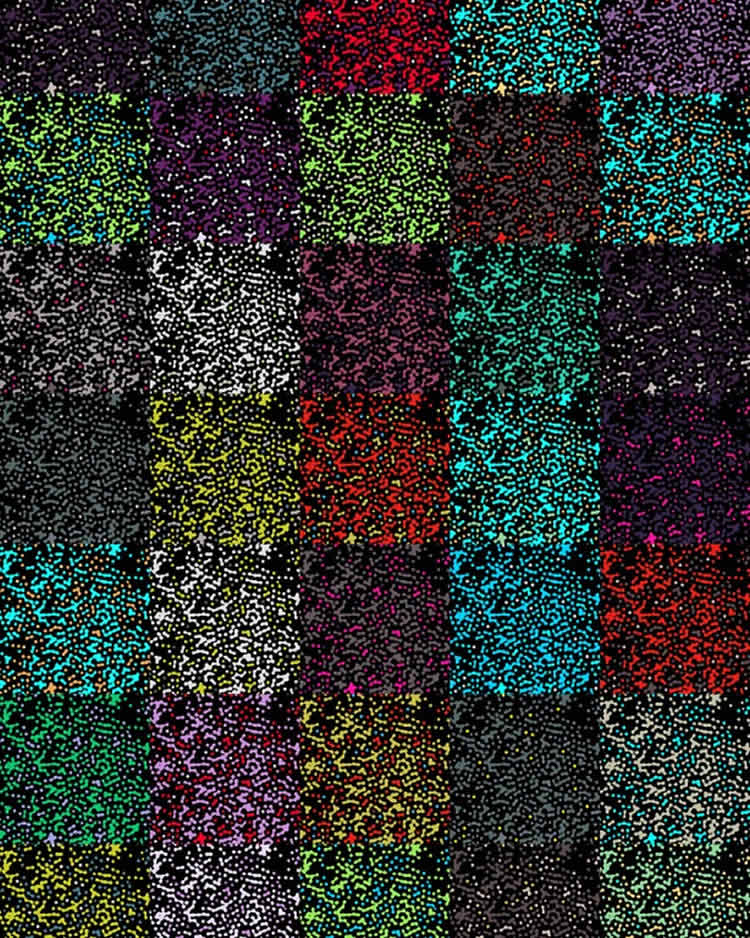Summary: A new study reports photoreceptors in the retina are sensitive to colors corresponding to their visual pigments.
Source: University of Bonn.
Scientists at University Eye Hospital Bonn investigate the retina at the level of individual sensory cells.
Dr. Wolf M. Harmening from University Eye Hospital Bonn, together with American colleagues, studied color vision by probing individual sensory cells – photoreceptors – in the human eye. The results confirm that the photoreceptor cells of the retina are especially sensitive to colors corresponding to their visual pigments, even when stimulated in isolation. A new observation is that proximity effects play a key role: sensitivity of tested photoreceptors varied depending on which cell classes were located in their immediate neighborhood. The results have now been published in advance online and will soon be published in the Journal of Neuroscience.
It is a constant ‘aha’ effect: when the light is switched on in a dark room, color vision sets in. “This not only makes the world more colorful,” says Dr. Wolf M. Harmening, who heads an Emmy Noether research group at Bonn University Eye Hospital. “Color also allows spatial detail to become apparent that has proven vital for survival over the course of evolution.” Some predator camouflage can only be identified through color. Poisonous animals and plants also provide warning signals through color. That human color vision emerges from three independent channels within the retina is well established in the vision science literature. By stimulating individual photoreceptor cells in living subjects, the lead authors Dr. Wolf M. Harmening from University Eye Hospital Bonn and Dr. William S. Tuten from the University of California, Berkeley, together with colleagues from the US universities in Seattle, Washington and Birmingham, Alabama, have now shown on a cellular scale how the human retina conveys color signals.
To do this, the researchers used an ophthalmoscope that can examine and stimulate the human retina non-invasively. The novel method – Adaptive Optics Scanning Laser Ophthalmoscopy – employs a combination of a laser and a very high-resolution microscope, which can even map individual sensory cells in the retina. The research team has now used this ophthalmoscope to study vision in the retinas of two human subjects. According to common theory, all color stimuli can be formed by mixing the primary colors red, green, and blue. While rod photoreceptors are specialized for seeing in the dark, cone photoreceptors convey color vision. They carry light sensitive pigments specialized to absorb wavelengths near the primary colors, the basis of trichromatic vision.
Mapping of the retina
The researchers initially mapped the cone mosaic on the subjects’ retinas by measuring light absorption for certain wavelengths in each photoreceptor. In this way, they were able to determine the sensory cells’ identity, or class, within the framework of trichromacy. By reducing the intensity of the stimulation light, the researchers were then able to determine a detection threshold in each cone, at which light was just barely seen by the subjects. “This is important because we could use the sensitivity of each cell to determine how overall perception is governed by the contribution of individual cones,” reports Harmening.

Most notably, the sensitivity of single cells also depended on the immediate neighboring cells. “If a cone sensitive to red light is surrounded by cells that are more sensitive to green, this cone is more likely to behave like a green cone,” summarizes Harmening. Studying visual processing of color is complex, in part because the brain does not receive raw data from individual photoreceptors but rather an already preprocessed retinal signal. Harmening: “Spatial and color information of individual cones is modulated in the complex network of the retina, with lateral information spreading through what are known as horizontal cells.”
Their finding supports previous assumptions about color vision. “What’s new is that we can now study vision on the most elementary level, cell-by-cell,” says the scientist. Conventional tests of vision use stimuli that necessarily activate hundreds to thousands photoreceptor cells at the same time. Harmening emphasizes that cellular-scale retinal computation such as the proximity effect has important implications, for basic and clinical research. “When the basis of vision is understood better, we open avenues for new diagnoses and treatments in case of retinal disease,” says Harmening. The novel single cell approach offers access to new findings in ophthalmology.
Source: Wolf M. Harmening – University of Bonn
Image Source: NeuroscienceNews.com image is credited to William S. Tuten/Wolf M. Harmening.
Original Research: Abstract for “Spatiochromatic interactions between individual cone photoreceptors in the human retina” by William S. Tuten, Wolf M. Harmening, Ramkumar Sabesan, Austin Roorda and Lawrence C. Sincich in Journal of Neuroscience. Published online September 4 2017 doi:10.1523/JNEUROSCI.0529-17.2017
[cbtabs][cbtab title=”MLA”]University of Bonn “Measuring the Basis of Color Vision.” NeuroscienceNews. NeuroscienceNews, 10 September 2017.
<https://neurosciencenews.com/color-vision-basis-7456/>.[/cbtab][cbtab title=”APA”]University of Bonn (2017, September 10). Measuring the Basis of Color Vision. NeuroscienceNew. Retrieved September 10, 2017 from https://neurosciencenews.com/color-vision-basis-7456/[/cbtab][cbtab title=”Chicago”]University of Bonn “Measuring the Basis of Color Vision.” https://neurosciencenews.com/color-vision-basis-7456/ (accessed September 10, 2017).[/cbtab][/cbtabs]
Abstract
Spatiochromatic interactions between individual cone photoreceptors in the human retina
A remarkable feature of human vision is that the retina and brain have evolved circuitry to extract useful spatial and spectral information from signals originating in a photoreceptor mosaic whose trichromatic constituents vary widely in their relative numbers and local spatial configurations. A critical early transformation applied to cone signals is horizontal-cell-mediated lateral inhibition, which imparts a spatially-antagonistic surround to individual cone receptive fields, a signature inherited by downstream neurons and implicated in color signaling. In the peripheral retina, the functional connectivity of cone inputs to the circuitry that mediates lateral inhibition is not cone-type-specific, but whether these wiring schemes are maintained closer to the fovea remains unsettled, in part because central retinal anatomy is not easily amenable to direct physiological assessment. Here we demonstrate how the precise topography of the long (L), middle (M), and short (S) wavelength-sensitive cones in the human parafovea (1.5⁰ eccentricity) shapes perceptual sensitivity. We used adaptive optics microstimulation to measure psychophysical detection thresholds from individual cones whose spectral types had been classified independently by absorptance imaging. Measured against chromatic adapting backgrounds, the sensitivities of L and M cones were, on average, receptor-type-specific, but individual cone thresholds varied systematically with the number of preferentially-activated cones in the immediate neighborhood. The spatial and spectral patterns of these interactions suggest that interneurons mediating lateral inhibition in the central retina, likely horizontal cells, establish functional connections with L and M cones indiscriminately, implying that the cone-selective circuitry supporting red-green color vision emerges after the first retinal synapse.
SIGNIFICANCE STATEMENT
We present evidence for spatially-antagonistic interactions between individual, spectrally-typed cones in the central retina of human observers using adaptive optics. Using chromatic adapting fields to modulate the relative steady-state activity of long (L) and middle (M) wavelength-sensitive cones, we found that single-cone detection thresholds varied predictably with the spectral demographics of the surrounding cones. The spatial scale and spectral pattern of these photoreceptor interactions were consistent with lateral inhibition mediated by retinal horizontal cells that receive non-selective input from L and M cones. These results demonstrate a clear link between the neural architecture of the visual system inputs—cone photoreceptors—and visual perception, and have implications for the neural locus of the cone-specific circuitry supporting color vision.
“Spatiochromatic interactions between individual cone photoreceptors in the human retina” by William S. Tuten, Wolf M. Harmening, Ramkumar Sabesan, Austin Roorda and Lawrence C. Sincich in Journal of Neuroscience. Published online September 4 2017 doi:10.1523/JNEUROSCI.0529-17.2017






